Autodesk Maya 2025.0 with Extensions Win x64
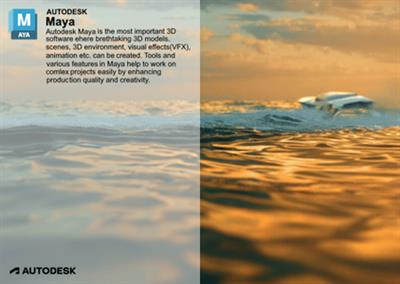
Free Download Autodesk Maya 2025.0 with Extensions | 8.7 Gb
Languages Supported: English, 日本語, 简体中文
Autodeskhas released Maya 2025, the new version of its 3D modeling and animation software. In summary, this update provides various enhancements. Nothing dramatic, but these new features and tweaks should improve your workflow.
Owner:Autodesk Inc.
Product Name:Maya
Version:2025.0 with Extensions *
Supported Architectures:x64
Website Home Page :www.autodesk.com
Languages Supported:multilanguage
System Requirements:Windows & macOs **
Size:8.7 Gb
Autodesk_Maya_2025_Windows_di_001_002.exe
Autodesk_Maya_2025_Windows_di_002_002.7z
Autodesk_Maya_2025_DEVKIT_Windows.exe *
Bifrost_2.9.0.0_Maya2025_Windows.exe
Autodesk_Maya_2025_macOS.dmg
Autodesk_Maya_2025_DEVKIT_Mac.dmg *
Bifrost_2.9.0.0_Maya2025_OSX.dmg
* Autodesk Maya provides an API to automate repetitive tasks and extend core software functionality, like customization of 3D modeling, animation, visual effects, rendering, and more-with C++, Python, and .NET supported. The SDK provides extensive functionality and code samples, as well as documentation to help get you started developing with the API.
3D modeling: Smart Extrude ported over from 3ds Max
The biggest change to the 3D modeling toolset in Maya 2025 is that the Smart Extrude system has been ported in from sibling application 3ds Max. First introduced in 3ds Max 2021.2 and updated steadily over the next three years, Smart Extrude is intended to provide a more intuitive way to extrude geometry than existing tools. It performs a combination of extrusion, cutting, merging and unioning as a single operation, making it possible to block out complex shapes quickly. Users can extrude faces interatively in the viewport, with Maya automatically rebuilding and stitching faces that have been cut through, reducing the need for manual clean-up.

Close
3D modeling: better bevels and edge extrusion
Maya's existing modeling tools have also been updated, with the Bevel node now able to filter input edges. Rather than applying a bevel operation to an entire mesh, the Poly Bevel Filter makes it possible to apply it only to selected edges, hard edges, or edges above an angle threshold. When applying a bevel to a mesh that was created as a result of a Boolean operation, by default, the bevel now only affects the edges created at the boolean intersection. If the Boolean input meshes are modified, the bevel updates automatically, as shown above. In addition, Extrude Edge now automatically creates UVs for the newly created edges or faces. The new UVs are offset from the original UVs in UV space, requiring less manual clean-up.
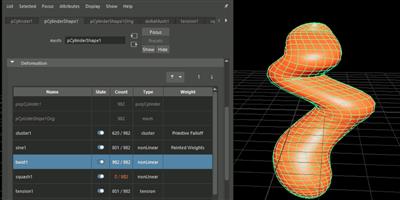
Close
Rigging: new Deformation widget
Character riggers get a new Deformation widget in the Attribute Editor, for viewing the deformers and topology modifiers affecting an object without having to use the Node Graph. It provides quick access to basic information about each deformer, like vertex counts and component types, and makes it possible to reorder, disable or reactivate deformers.
Rigging: updates to Proximity Wrap, the Bake Deformer tool, and joint workflow
Updates to existing rigging features include the option to use the Proximity Wrap deformer as a proxNet deformer, to make a deforming driver geometry apply its influence relative to another deformed version of the driver, rather than its original undeformed shape. The workflow is probably easier to understand if you look at the example provided in the online documentation, which shows Proximity Wrap deformers being used to rig an arm. The Bake Deformer Tool - used for baking down complex rigs for export to game engines and other apps with limited support for deformers - gets another update, with the new Range of Motion option making it possible to sample poses only from a specific point in an animation. Other changes include the option to adjust the text size of joint labels, and to automatically orient the secondary axis of a joint from the Orient Joint Options and Joint Tool settings.
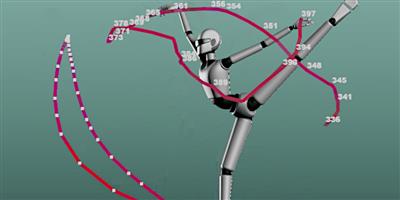
Close
Animation: new unified Motion Trail editor
Animators get a new Motion Trail Editor, accessible from the Visualize menu. It brings together settings that were previously scattered across several different windows in the Maya interface, including the Outliner, Channel Box and Attribute Editor.
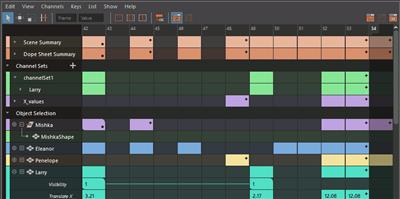
Close
Animation: updates to the Dope Sheet and Graph Editor
Maya's existing animation tools have also been updated, with the Dope Sheet getting a significant overhaul. The update gives it a "cleaner, better organized interface", more like the Graph Editor, with new visual indicators for keyframe properties, and customizable colors to identify sets of keys. Workflow for interacting with keyframes has been improved, including a new Ripple Edit function for moving and scaling keys. The Graph Editor gets new keyboard shortcuts for curve sculpting.
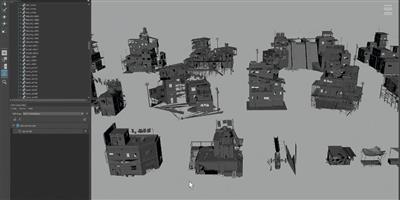
Close
Look dev and layout: updates to the LookdevX and USD for Maya plugins
Outside the core application, LookdevX, the new toolset for creating USD shading graphs introduced in Maya 2024, gets another update, with LookdevX 1.3 adding support for MaterialX. Users can now use USD and MaterialX shading graphs simultaneously within the same Maya session, and can assign MaterialX materials directly to Maya geometry. Maya's USD support has also been further extended, with USD for Maya 0.27, the latest version of the Universal Scene Decription plugin, making it possible to bulk load and unload prims. It is also now possible to move, rotate and scale prims directly in the viewport using Maya's Universal Manipulator. There are also a number of smaller improvements and updates to Hydra for Maya.

Close
Rendering: MaterialX support and better GPU rendering in MtoA 5.4
Maya's integration plugin for Autodesk's Arnold renderer gets a significant update, with MtoA 5.4.0 adding support for MaterialX shader networks in LookdevX. Other changes include support for dithered samples in progressive and adaptive rendering, generating "nicer noise distributions" at lower antialiasing sample counts. A "large part" of Arnold's GPU render engine has also been rewritten using OptiX 8, the current version of NVIDIA's GPU ray tracing framework, making start-up "significantly" faster, and improving performance scaling on multiple GPUs. The GPU engine also now supports multiple render sessions. Other changes include support for global light sampling in volumes, support for toon light group AOVs, and a new Overlay imager for printing text over rendered images.

Close
Simulation: Bifrost 2.9 adds new options for simulating ocean waves and meshing liquids
Maya's Bifrost extension also gets a sizeable update, with Bifrost 2.9.0.0 adding the BOSS (Bifrost Ocean Simulation System) features from the older Bifrost Fluids toolset. Just like the original versions, they can be used to simulate wind-driven spectral waves, complete with foam, but can also be controlled via the underlying Bifrost graph. In addition, a new points_to_liquid_surface compound makes it possible to mesh point caches from Bifrost Fluids simulations, as well as sources such as MPM simulations in the graph.
Updates to the other plugins and the Maya Bonus Tools
Maya's Substance plugin, for editing procedural materials in Adobe's Substance 3D format, has also been updated, with Substance 2.5.0 using the GPU by default, improving performance. In addition, the Maya Bonus Tools, Autodesk's free collection of experimental Maya tools and scripts, is now included in the Maya installer, rather than being a separate download.
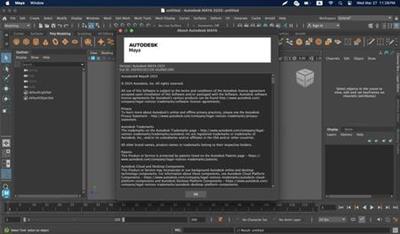

Autodesk Mayais an industry leading 3D digital content creation software used extensively by movie, game, and FX studios both big and small. It features a wide range of tools for every step of the creation process, including (but not limited to) modeling, rigging, animation, FX, rendering, motion graphics, and more.
Autodesk Maya 2025presents features updates throughout Maya's core toolsets, adding 3ds Max's Smart Extrude system, and a new Deformation widget and unified Motion Trail editor for rigging and animation. Look development toolset LookdevX gets native support for MaterialX shading graphs, and USD for Maya gets support for bulk loading and unloading of USD prims. Simulation add-on Bifrost for Maya now includes the Bifrost Ocean Simulation System from the older Maya Fluids toolset, while Autodesk's Arnold renderer gets better GPU rendering.
What's new in Maya 2025
Unlock your full creative potential and improve collaboration in Autodesk Maya with new and improved modeling, animation, and simulation capabilities, as well as more tightly integrated open-source technologies, like LookdevX and MayaUSD.
Autodeskhelps people imagine, design and create a better world. Everyone-from design professionals, engineers and architects to digital artists, students and hobbyists-uses Autodesk software to unlock their creativity and solve important challenges.

Rapidgator
http://peeplink.in/bc81e17ab5bc
NitroFlare
9tlsb..setup.part1.rar
9tlsb..setup.part2.rar
9tlsb..setup.part3.rar
Uploadgig Free Links
9tlsb..setup.part1.rar
9tlsb..setup.part2.rar
9tlsb..setup.part3.rar
Fikper Free Links
9tlsb..setup.part1.rar.html
9tlsb..setup.part2.rar.html
9tlsb..setup.part3.rar.html
Links are Interchangeable - No Password - Single Extraction
